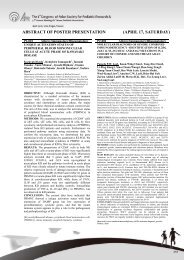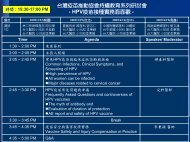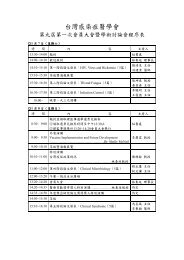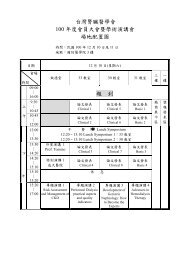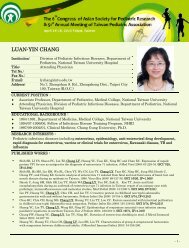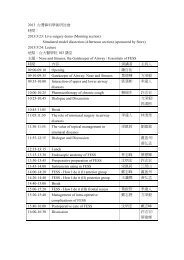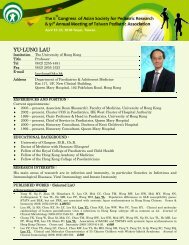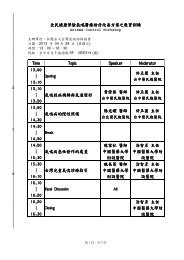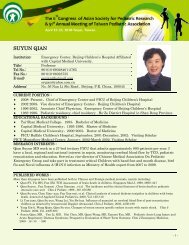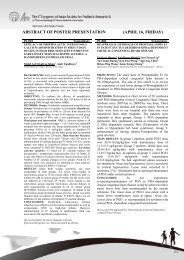ABSTRACT OF INVITED LECTURES AND ORAL PRESENTATION
ABSTRACT OF INVITED LECTURES AND ORAL PRESENTATION
ABSTRACT OF INVITED LECTURES AND ORAL PRESENTATION
- No tags were found...
You also want an ePaper? Increase the reach of your titles
YUMPU automatically turns print PDFs into web optimized ePapers that Google loves.
MS7-03INTRAHEPATIC CHOLESTASIS- TODAY <strong>AND</strong>TOMORROWHuey-Ling Chen, M.D., Ph.D.Associate Professor, Department of Pediatrics, National Taiwan University,College of Medicine and Hospital, Taipei, TaiwanCholestasis is a common manifestation of inherited or acquiredliver diseases in pediatric patients. Recent advances inunderstanding the molecular mechanisms of bile transport andphysiology have facilitated the diagnosis of many cholestatic liverdiseases previously thought to be idiopathic. Highly diverseetiologies and overlapping symptoms make the diagnosis ofpediatric cholestasis challenging.The primary etiologies of intrahepatic cholestasis includeinfectious diseases, inherited liver transport disorders, metabolicdisorders, ductal-plate malformations, chromosome anomalies andendocrine disorders. Ischemia, drugs and parental nutrition havealso been indicated as secondary causes of intrahepaticcholestasis. Progressive familial intrahepatic cholestasis (PFIC) isa group of disorders characterized by early onset cholestasis,progressive liver cirrhosis and hepatic failure during the first orsecond decade of life. Within this group, three types of geneticdefects have been identified. Characterized by low serum GGTlevels, PFIC-1 and -2 are caused by mutations in the ATP8B1(FIC1) and ABCB11 (BSEP) genes, respectively. PFIC-3 ischaracterized by high serum GGT levels and is caused by geneticmutations in ABCB4 (MDR3). Inborn errors of bile acid synthesisresult in a deficiency of primary bile acids and abnormal bile acidmetabolites, resulting in progressive intrahepatic cholestasis andlow serum bile-acid levels. The above-mentioned geneticdisorders are also responsible for minor forms of cholestatic liverdiseases in adults: benign recurrent intra-hepatic cholestasis,drug-related cholestasis, intrahepatic cholesatsis of pregnancy, andcholesterol gall-bladder stones.Aberrant ductal formation during the development of the livercontributes to unique forms of intrahepatic cholestasis. Alagillesyndrome is an autosomal dominant disorder caused by JAG1 orNOTCH2 mutations. Intrahepatic ductal paucity, peripheralpulmonary artery stenosis, and other organic anomalies arecharacteristic of this syndrome. Other forms of ductal platemalformation can also cause intrahepatic cholestasis andfibrocystic diseases of the liver and kidney.A recently discovered neonatal cholestatic disorder caused bycitrin deficiency (NICCD) was found to be more prevalent inAsian countries. Common mutations, including 1638ins23 and85del4 in the SLC25A13 gene were found in Asian patients.Heterozygous carriers of these mutations are prevalent in thenormal population. Cholestasis is resolved during the first year oflife in most patients. Occasionally, some patients are affected byadult-onset type II citrullinemia (CTLN2).The treatment for intrahepatic cholestasis includes nutritionaltherapy and choleretic agents. Donor shortage and higher surgicalrisks for infants pose challenges for patients in need of livertransplantation. Nuclear receptors are being investigated aspotential therapeutic agents for intrahepatic cholestasis.Hepatocyte transplantation is also under experimentalinvestigation.MS7-04LIVER TRANSPLANTATION IN CHILDREN:RECENT ADVANCESSeng-Hock QuakDepartment of Paediatrics, University Children’s Medical Institute,National University Hospital, SingaporeOrthotopic liver transplantation (OLT) is the treatment option forpatients with end stage liver disease and is widely accepted inmany Asian countries. The results of OLT is excellent with longterm survival rate of well above 80%. The quality of life after OLTis extremely good and the vast majority of the recipients are able tofunction normally without much limitation to their daily activities.Organ shortage is a major problem in OLT and many of thepatients expired before a donor organ is available. As such,surgical techniques using split liver and living donors areimportant advances in recent years. The surgical outcome of thesetwo procedures is comparable to those using cadaveric grafts.Organ rejection is always a problem in transplantation. In fact thesuccess of OLT is greatly enhanced by the discovery ofanti-rejection medications such as cyclosporine and tacrolimus.However these medications are known to have a number of seriouscomplications including renal toxicity. A number of newer drugswhich are less nephrotoxic are now available.Infection is an important issue in OLT. There are a number of riskfactors which include pre-transplant malnutrition, poor immunefunction in patients with end stage liver disease and the operationitself. Immediately after the operation, the recipient is usuallyintubated with many invasive intravenous lines and drainage tubes.The use of anti-rejection drugs also suppresses their immunefunction. Other than bacterial infection, viral infection and fungalinfections are particularly problematic among the recipients. Theuse of prophylactic gancyclovir has greatly reduced the rates ofsymptomatic cytomegalovirus (CMV) infection. Risk factors forfungal infections include multiple operations, CMV infection,prolonged antibiotics usage and multiple rejections.Hepatitis B infection had been a contraindication for OLT.However, patients with hepatitis B infection are suitable for OLT inrecent years because it is possible to control viral replication withthe use of nucleoside analog, hyperimmune gammaglobulin andvaccination. In recent years, OLT is a treatment option for patientswith liver cancer, provided that the cancer is confined to the liverand not more than certain acceptable size. In children, Ebstein Barrvirus and Herpes infections are common. These infections areassociated with post-transplant lymphoproliferative disease(PTLD). Fortunately in many patients, the PTLD would improve ifthe immunosuppressants are reduced in time. Monoclonalantibodies can be used to treat PTLD and the outcome issatisfactory.In conclusion, neonatal and infantile cholestasis is a commondisorder with highly diverse etiologies, making the diagnosis achallenge for clinicians. Research is been carried out to improvediagnosis and treatment, as well as to elucidate the etiology ofcryptogenic diseases104






